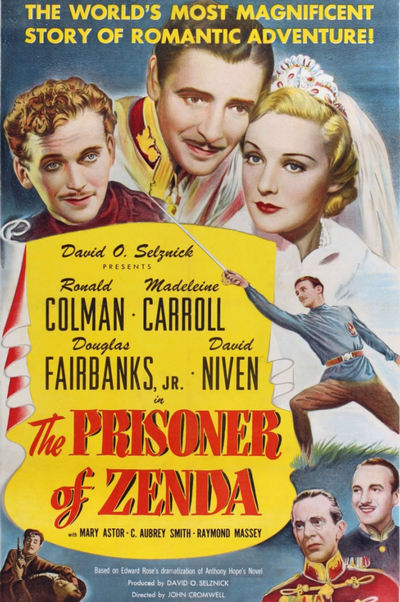


His writing career was waning, but he lived comfortably on the film rights and royalties from new editions of the Prisoner of Zenda until his death on July 8th, 1933. Fame and acclaim came two years later to his nephew, Anthony's first cousin, Kenneth Grahame, with the publication of The Wind in the Willows in 1908.įor his wartime propaganda work, Sir Anthony Hope Hawkins was knighted in 1918. Edwards died at 78 on February 12th, 1906. By now he was living in the shadow of his son's glory and was largely forgotten as an author and journalist.

A year later, Edwards Comerford Hawkins retired from Fleet Street. In 1903, Hawkins married Elizabeth Somerville Sheldon, an American 22 years his junior. Hawkins made up his mind - he gave up the wig for the pen, and more Ruritanian novels followed, including The Heart of Princess Osra (1896), Rupert of Henzau (1898), The King's Mirror (1899) and Quisanté (1900). When it was published just over three months later, in April 1894, The Prisoner of Zenda was an instant success. He wondered what might happen if they had the same name, swapped places and walked off, each in the other's direction, passing himself off as his look-alike.īack at his father's vicarage, he began to create Ruritania, and within a month, using the name Anthony Hope, he had finished a new novel about two Rudolfs, The Prisoner of Zenda: being the history of three months in the life of an English Gentleman. As he walked on, two men passed him by separately, one after the other, both sharing uncannily similar features. On the afternoon of November 28th, 1893, after winning a case in Westminster County Court, Anthony was walking back to the Temple, playing in his mind with the word "suburb" and the Latin phrase rus rur (countryside), entertaining thoughts of an unknown, unnamed foreign kingdom. He began contributing short stories and society sketches to the Westminster Gazette, and as he balanced wig and pen in Fleet Street Anthony lived with his widowed father at St Bride's Vicarage.įrom childhood, Anthony was fascinated with look-alikes and doubles, and later he followed the Titchborne case as his cousin, Sir Henry Hawkins, exposed the claimant to the title as a fraudster. Despite a brief flirtation with politics - he failed as a Liberal candidate in South Buckinghamshire - young Hawkins found his real interest was in journalism and writing. For a while, Anthony practised at the bar and shared chambers with a future Prime Minister, Herbert Henry Asquith. The youngest Hawkins boy, Anthony Hope Hawkins, went to St John's while his father was headmaster, before going on to Marlborough and Balliol, Oxford. An invitation from the Dean of Westminster in 1883 to become Vicar of St Bride's, the journalists' church in Fleet Street, had obvious attractions and Hawkins soon published a history of Wren's church. The school was founded in 1851 for the sons of poor clergy, but by 1872, when St John's moved to Leatherhead in Surrey, Hawkins had transformed it into an English public school.īy now Hawkins was also a well-known journalist and writer, contributing to Smith's Dictionaries and publishing Spirit and Form in 1881. In 1861, Edwards Comerford Hawkins became headmaster of St John's Foundation School. Rev Henry Ernest Casey became Vicar of Berrow Rev George Edwards Comerford-Casey was a teacher at Nottingham High School before moving to Nice Rev William Henry Casey was a curate in Liverpool and Rev Henry Hawkins was a Victorian pioneer in mental health care. It came as no surprise when Edwards Comerford Hawkins entered the ministry of the Church of England - four of his first cousins were clergymen too. There were so many look-alike Comerford-Casey and Hawkins cousins that they often played at passing themselves off as each other.

The Comerford-Casey family fortune came from the soap industry in Liverpool, but medicine and the law became the main professions of the family members, who moved with ease between their homes in Cork, Hitchin and Liverpool. Dr Frederick Hawkins of Hitchin, his sister Anne, and their cousin Susanna Hawkins all married into the Casey family of Cork, their spouses being two of the sons and a daughter of Edwards Casey of Cahirgal and Elmgrove Grove, Cork, and his wife, Jane Comerford. The only son of a Hertfordshire doctor, he was born on May 15th, 1827. His fame as a Victorian writer and journalist has vanished in the intervening century, but his literary reputation continues vicariously through a more famous son and nephew. Yesterday was the 100th anniversary of the death of the Rev Edwards Comerford Hawkins, a journalists' parson and a writer with a strong Irish background.


 0 kommentar(er)
0 kommentar(er)
